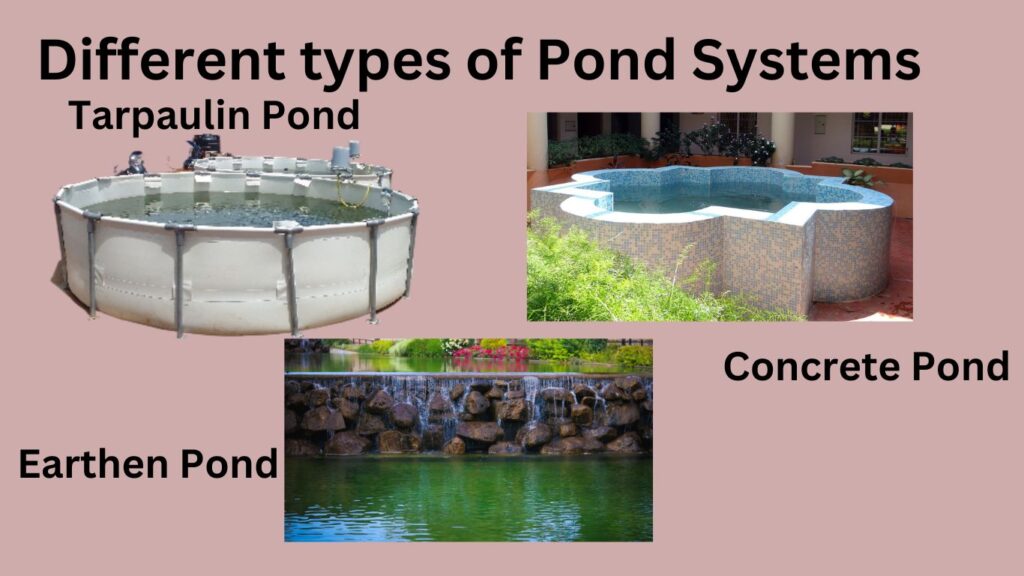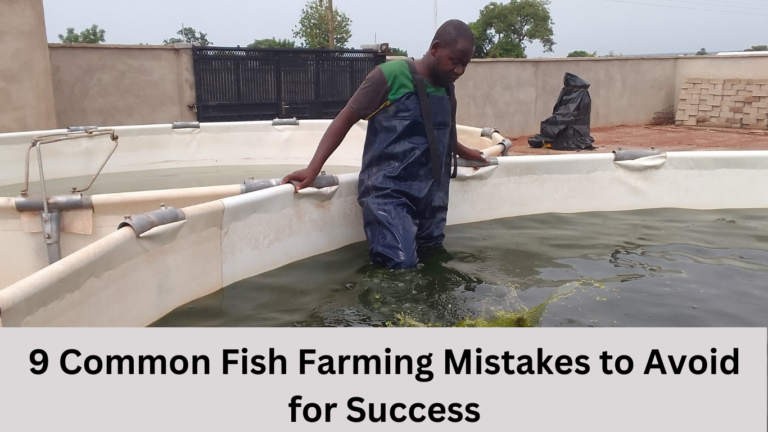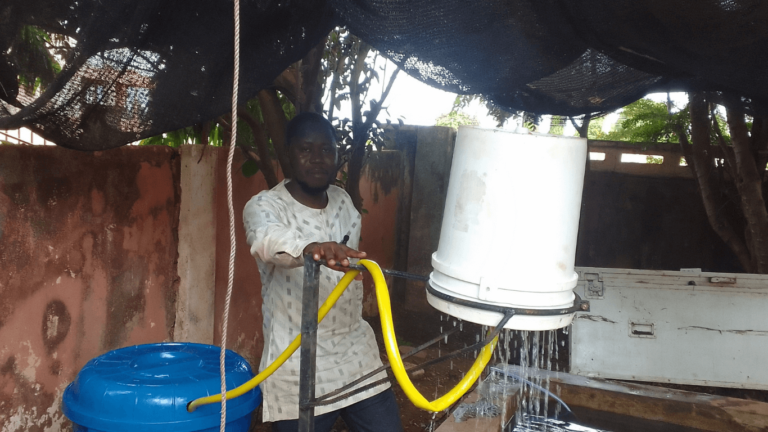9 common fish farming mistakes to avoid is great information every fish farmer must know in order to be successful in fish farm operations. One of the most painful experiences for any fish farmer is to see their fish die due to avoidable mistakes. Fish farming success depends on knowledge, preparation, and adherence to best practices.
In this article, we’ll discuss 9 common fish farming mistakes to avoid as fish farmers. These insights can help both seasoned and beginner farmers improve their practices and increase their chances of success.
1. Improper Fish Farm Setup
The first and most crucial step in fish farming is ensuring that your setup is correct. Whether you’re using plastic, concrete, tarpaulin, earthen, or cage ponds, having the right setup is essential.
A poorly constructed setup is one of the 9 common fish farming mistakes to avoid because it will hinder your production process, causing delays, inefficiencies, or even catastrophic losses.
Setting Up Different Types of Ponds
– Plastic Tanks: Ensure that the materials you use are durable and suited for your pond’s size. For example, plastic tanks should have plastic bases, not wooden ones, as wood will rot over time, compromising the integrity of your setup.
– Concrete Tanks: Always check for leakages before introducing water and fish into the tank. If necessary, cure your tanks properly to avoid chemical reactions that can harm the fish. Curing your fish pond before stocking is very crucial. I know someone who lost thousands of fish because of failure to cure concrete ponds. You can check this post for steps to steps guide on how to cure your concrete pond.
– Cage Farming: Ensure that your cages are well-anchored and placed in suitable water bodies. Poorly anchored cages can drift or get damaged, exposing your fish to predators or unfavorable conditions.
– Tarpaulin Fish Pond: This is made from tarpaulin lining where the tarpaulin is sewn and erected with frames supporting it to stand. The frame can be wooden, metal, or PVC. Also, make sure it is free from leakage. Tarpaulin fish pond is also subjected to predators but they can be controlled by predation nets.

2. Sourcing Poor-Quality Fingerlings
Another one of the common fish farming mistakes to avoid which is made by many farmers is sourcing weak or unhealthy fingerlings. The quality of your fingerlings plays a huge role in determining the success of your farm. Weak fingerlings will have a higher mortality rate, leading to significant losses.
How to Source Quality Fingerlings
Always purchase fingerlings from a hatchery with a proven track record of producing strong, healthy stock. Resist the temptation to buy from unverified sources, even if the price is lower. In the long run, high-quality fingerlings will save you time, money, and stress.
3. Poor Water Quality Management
Water quality is vital in fish farming. The better the water quality, the healthier your fish and the better your production outcomes. Fish farmers should regularly test their water to ensure it meets the necessary parameters for raising fish.
Managing Water Quality
– Natural Water Sources: If your water comes from a well, river, or stream, it’s essential to have it tested by professionals like the Water Research Institute. They can tell you whether the water is safe for fish farming or if it needs treatment.
– Chlorinated Water: If your water is from a municipal supply and contains chlorine, simply leaving the water out in the sun for a day or two will help the chlorine evaporate. This makes it safe for your fish.
4. Infrequent Water Changes
In farms that do not use recirculating systems, frequent water changes are essential. A common mistake made by fish farmers is delaying water changes, which can lead to high ammonia levels, stress, and disease outbreaks among fish.
Best Practices for Water Changes
Change your water on time, based on the specific needs of your farm. For example, if the recommendation is to change water every three days, ensure you adhere strictly to this schedule. Delaying by even a day can lead to significant losses. When changing the water, avoid doing so in the afternoon when water from pipelines is often warmer, as this can stress the fish.
5. Inaccurate Record Keeping
Proper record-keeping is the backbone of any successful fish farm. Keeping accurate records allows farmers to track their mortality rates, feeding habits, water quality, and more. Without this data, it becomes difficult to identify problems and make informed decisions.
Importance of Record Keeping
Accurate records help you:
– Monitor fish health and growth
– Track feeding efficiency
– Manage budgets and predict future costs
– Spot trends that may lead to problems, such as disease outbreaks
Farmers should keep detailed records of daily activities, including feeding times, water changes, mortalities, and any issues with water quality. With accurate records, you’ll be able to troubleshoot problems faster and with more precision.
6. Feeding Mistakes
Fish feeding is one of the most crucial aspects of fish farming, and improper feeding is a common mistake that can drastically affect your farm’s productivity. Overfeeding or underfeeding can lead to a host of problems, including water pollution, stunted growth, and wasted resources.
Avoiding Overfeeding and Underfeeding
– Overfeeding: When you overfeed your fish, the uneaten food will sink to the bottom of the tank, where it decays and pollutes the water. This can cause an increase in water acidity and ammonia levels, which can stress or kill your fish.
– Underfeeding: Underfeeding, on the other hand, leads to stunted growth and malnourishment. It may also extend the production cycle, delaying the time it takes for fish to reach market weight, which will cost you more in the long run.
Use a feeding chart that takes into account the size and quantity of fish you have. This will ensure that your fish receive the right amount of food based on their size and needs.
7. Failing to Sort Fish at the Right Time
Fish farmers must sort their fish at different stages of growth. Failure to do so can result in larger fish preying on smaller ones, a phenomenon known as cannibalism. This can lead to high mortality rates, even without disease present on your farm.
The Importance of Sorting
– Cannibalism Prevention: Regularly sorting your fish ensures that larger, more aggressive fish are separated from smaller, more vulnerable ones. This prevents them from competing for food or attacking each other.
– Feeding Efficiency: Proper sorting also ensures that fish receive the appropriate feed for their size. If you mix fish of varying sizes in one tank, the larger fish may take more food, leaving the smaller fish malnourished.

8. Incorrect Stocking Density
Stocking density refers to the number of fish you have per unit of water in your pond. Stocking too many fish in a small space can lead to overcrowding, increased competition for food, poor water quality, and disease outbreaks.
Calculating the Right Stocking Density
For optimal results, it’s important to calculate the right stocking density for your specific setup. For instance, in a rectangular pond, the stocking density is determined by multiplying the length, width, and height of the pond to get the volume of water in liters. In every 10 liters of water, you should have about 1 kilogram of fish.
Overstocking leads to slow growth and increases the risk of mortality. Even if you get more fish at the end of your production cycle, they may not meet market size requirements, affecting your farm’s profitability.
9. Poor Biosecurity Practices
Biosecurity refers to the measures you take to protect your farm from diseases and contaminants. A lack of biosecurity protocols can expose your fish to harmful pathogens that can wipe out your stock quickly.
Essential Biosecurity Measures
– Quarantine New Stock: Always quarantine new fish before introducing them to your main farm. This allows you to check for any signs of disease and treat them if necessary.
– Sterilize Equipment: Regularly disinfect nets, tanks, and other equipment to reduce the risk of spreading bacteria or viruses between tanks.
– Restrict Farm Access: Limit the number of people who have access to your farm, and ensure that anyone who enters follows strict hygiene protocols. Visitors can easily bring harmful pathogens onto your farm.
Conclusion
Fish farming can be highly profitable, but it requires careful planning, attention to detail, and a commitment to best practices. By avoiding these fish farming mistakes — from improper setup to poor water management and biosecurity — you can significantly increase your chances of success.
Remember that ongoing education and training are crucial for staying up-to-date with the latest techniques in fish farming. If you’re serious about improving your fish farm, consider getting our Comprehensive Fish Guide eBook in your hand.




